Lime Mortars for High Exposure Levels
Clare Torney
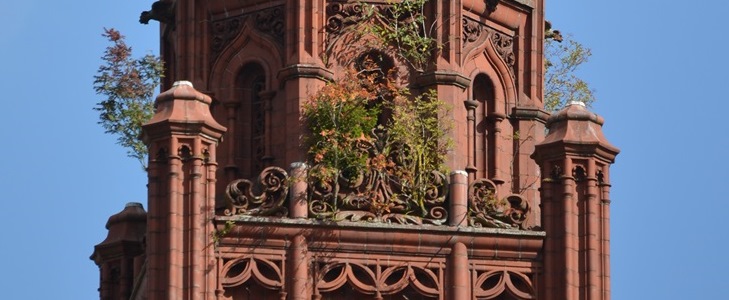 |
|
| Buddleia and other plants exploiting the failure of high level mortar joints in the terracotta tower of Central Hall, Birmingham |
Prior to the patenting of Portland cement in 1824 and its subsequent wide-scale adoption, lime was usually the material of choice in masonry construction due to its availability, versatility and compatibility with other components. Before widespread transport of materials was established, and where neither lime nor Portland cement were available locally, earth or clay mortars might be used. Although the availability of raw materials was initially the main driver in the popularity of lime mortars in historic times, their compatibility with natural stone played a key role in their longevity, both in relation to their widespread use and their physical durability. Following a rise in the popularity of Portland cement in the 20th century, recent decades have seen a decline in its use for conservation works due to its incompatibility with traditionally constructed stone, brick and terracotta masonry, and a resurgence in the use of lime mortars in this context.
It is the micro-structure of lime mortars that promotes their compatibility with traditional masonry. Mass masonry construction relies on ‘moisture management’ – the unconstrained movement of moisture, through a building or structure, to maintain a level of moisture equilibrium that promotes building ‘health’. The principal components of all lime mortars – lime binder, aggregate and water – and the reactions and interactions that occur during their production, mixing and curing, typically result in the formation of a relatively open-textured material.
The voids or pores in the mortar are interconnected through cracks in the binder (in other words, the mortar is microporous). These pathways allow the mortar to transmit fluid, a property termed permeability. Because these pathways also allow the transmission of water vapour such materials are often said to be ‘breathable’. High permeability or breathability is perhaps one of the most important properties in dictating compatibility between materials, and is one of the primary factors in the incompatibility of highly cementitious mortars with traditional masonry. Cement mortars and other low permeability materials, such as resin-based mortars, are high-density binders that lack microporosity, resulting in trapped moisture (see Robyn Pender’s article on permeable building materials).
Stone deterioration is often the first visual indicator of the incompatibility between traditional masonry and cement-rich mortars. The over-exposure of the stone to moisture resulting from use of a low permeability mortar can cause many forms of deterioration including granular disintegration, delamination and blistering. As moisture penetrates a building, this may lead to concentration of salts in the stone, corrosion of metal supports, rotting of timbers and deterioration of internal surfaces and finishes through penetrating damp.
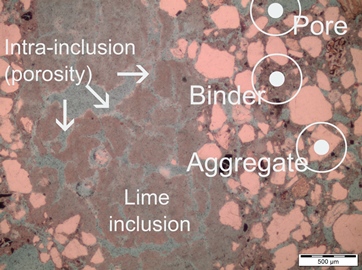 |
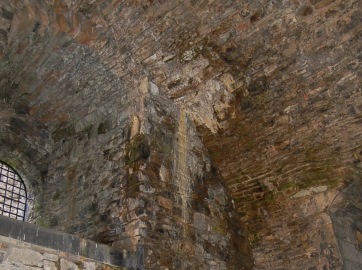 |
|
| Petrographic thin section of a hot lime mortar with high porosity (indicated by blue areas): note the partially slaked lime inclusion (left and centre) | Leaching of lime binder due to percolation of water, which has also resulted in greening of masonry (Photo: Historic Environment Scotland) |
These problems can be avoided through an understanding of building design and materials. Successful repairs rely on matching the properties of the repair material to those of the existing historic fabric as closely as possible. However, an additional set of requirements is often imposed by the environment, adding a degree of complexity to the process. Mortars used in areas of high exposure are subjected to more aggressive weathering agents such as strong winds, wind-driven rain, frost and percolating water. Specifying mortars for pointing at high level (for example in wall-heads, parapets and chimneys), where these extreme conditions are encountered more frequently, poses more challenges. The problems posed by environmental conditions should be considered at the specification stage and, in most cases, the design of a mortar can be modified to take account of the specific challenges posed. There are a number of features of mix design and preparation that can be considered in tackling the specific problems encountered in high exposure environments, and these are outlined below.
AVOIDING FROST DAMAGE
Exposure of mortars to low temperatures and frost can lead to freeze-thaw damage, causing the mortar to fail or ‘burst’. Carbonation of lime mortar is key in minimising frost damage. Carbonation and drying reduce pore water and promote the formation of a network of pores which gives the mortar a level of resistance or tolerance to the expansive forces imposed during freezing conditions. Where environmental conditions inhibit carbonation (such as in very wet areas) the use of a hydraulic lime is more appropriate. Hydraulic mortars have a more rapid strength-gain achieved via the hydration of calcium- and aluminium-silicates.
Whether using hydraulic or non-hydraulic limes, mortar resistance to frost damage can be enhanced by several ways, such as the use of a calcitic aggregate or a hot lime mix, or simply by controlling the temperature while it carbonates.
Calcitic aggregates The use of calcitic aggregates such as crushed limestone and oyster shell has been shown to aid carbonation. These materials act as seeding agents in the mix providing nucleation sites for the precipitation of calcite crystals, promoting the carbonation process. The purity, crystallinity, particle size and quantity of seeding agents all impact their performance. Finely ground pure sources of calcium carbonate (substituted for aggregate) in concentrations above six per cent have been found to positively impact carbonation and strength development.
Hot lime mortars Making a mortar by mixing water and aggregate with quicklime, rather than with previously slaked hydrated lime, produces an exothermic reaction that generates heat. The combination of heat and high alkalinity experienced during the mixing of these hot lime mortars is believed to produce a more durable mortar. Microstructural changes seen in these mortars are likely to be beneficial, enhancing its durability. In particular, mortars which have been laid shortly after slaking have been shown to have more interconnected voids (see petrographic image above left), perhaps as a result of the steam. This void structure would increase the mortar’s tolerance to frost damage. It has also been speculated that the combination of heat and alkalinity leads to an ‘etching’ of the surface of aggregate grains, creating a stronger bond than would be achievable in mortars mixed with previously slaked lime, although this remains unverified.
Temperature control Protection of mortar following application can play an important role in preventing, or at least minimising, freeze-thaw damage, allowing the mortar to cure sufficiently before it is exposed to harsh conditions. The use of lime mortars in temperatures of 5ºC or below is not recommended and following application it is advisable to cover mortar with layers of hessian and tarpaulin (or other protective materials). Heated scaffold systems can provide a solution to the problem of frost damage but this is not always a practical or economically viable approach. Where temperatures are not controlled adequately, it could also lead to other problems such as the mortar drying too rapidly.
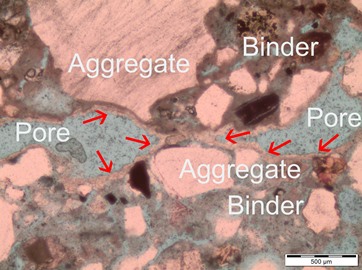 |
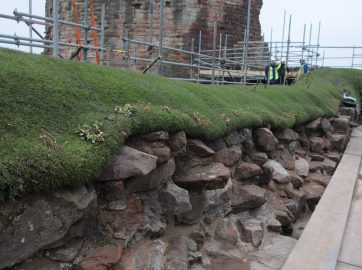 |
|
| Petrographic thin section of a lime mortar: free lime re-precipitated within a mortar (indicated by arrows) can block pores reducing permeability | Soft capping can be used to help deal with high levels of moisture in exposed areas. (Photo: Historic Environment Scotland) |
EXPOSURE TO DRIVING RAIN
Mortars used for pointing at high level are more exposed to rainfall than those at a lower level which are better sheltered from the elements, particularly where they are protected by drip detailing. Furthermore, projecting elements such as chimneys and parapets have more than one face exposed. The continuous percolation of water through mortar will lead to the dissolution and re-deposition (or ‘re-precipitation’) of lime binder (illustrated above). Although this usually occurs on a small scale it can result in a material that lacks uniformity, being weak and friable in some areas and much denser in others. When the binder re-precipitates, this can partially block pores (see petrographic image above right) and is likely to reduce the breathability of the mortar. On a larger scale this can lead to the washing out of wall cores and building collapse.
The susceptibility of a mortar to binder leaching is dependent largely on its composition. Calcium is present in lime mortars in a number of forms: calcium silicates (the primary hydraulic components of natural hydraulic limes), calcium carbonate (carbonated lime) and calcium hydroxide (uncarbonated lime). The calcium in silicate minerals is insoluble and is not affected by leaching. Calcium carbonate and calcium hydroxide, however, are both water-soluble and as such can be leached (the lime ‘available’ for leaching from a binder is called free lime). The leaching of calcium carbonate is a slow process due to its relatively low solubility but, where the right conditions exist, over time it does occur. The solubility of calcium hydroxide is much higher, which is why uncarbonated mortars are more susceptible to leaching.
Where mortars are likely to be subjected to percolation of water (for example in wall heads and parapets), it is advisable to use a binder with a low free lime content. However, free lime does provide lime mortars with positive performance attributes such as flexibility and small-scale self-healing (on very long timescales), so there is a balance to be struck when selecting binders. Binders of higher hydraulicity typically have lower free lime contents, but variations do exist between limes from different sources. Free lime content is usually stated in the manufacturers’ technical data.
Pozzolans can also be used to reduce the free lime available but as they also affect the microstructure of the mortar, gauging a non-hydraulic lime with a pozzolan is likely to result in a mortar with lower permeability than one based on the equivalent hydraulic lime.
Providing new works with adequate protection against moisture ingress reduces the likelihood of uncarbonated material leaching while the mortar carbonates. The use of protective materials need not be restricted to waterproof membranes and covers; the use of soft-capping (illustrated above) has been successful in dealing with high levels of moisture in exposed conditions, and reduces the time-frames (and therefore costs) over which scaffolding is required.
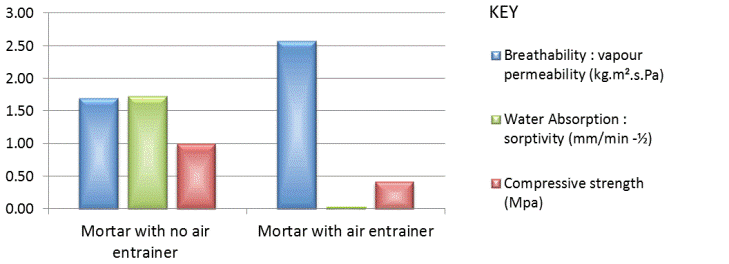 |
| Differences in breathability, water absorption and compressive strength between mortars with and without air entrainers (tested at 28 days) |
ADDITIVES: IMPACT ON MORTAR PROPERTIES
Traditionally, natural additives were added to lime mortars during mixing to alter specific aspects of mortar performance. Additives include tallow or linseed oil to enhance water resistance, and urine to increase workability. In some of today’s construction and conservation work, chemically equivalent additives are still used.
Using additives in mortars can be beneficial. For example, air entrainers result in higher porosity and breathability so they could provide a greater level of protection from frost. However, due to the interrelationships between strength, porosity, permeability, breathability and other factors, additives rarely impact one property without also affecting another, so the intended positive effect might be offset by negative changes.
In the case of air-entraining agents, water absorption (by capillarity) of the material is significantly reduced (see graph above). This means that the material has a lower permeability and could lead to problems associated with moisture distribution where mortars are used on large scales. Such mortars could shed water rather than absorbing it, which might lead to increased stresses on masonry lower down the facade as a result of the increased run off.
Furthermore, mortars with additives tend to be more sensitive to workmanship considerations. Over-mixing and addition of excess water is likely to have more of an impact on mortars containing additives compared with those simply consisting of lime and aggregate.
The use of additives in mortars for conservation work should be limited to cases where their impact is thoroughly understood. Any potential negative impacts should be highlighted and judged against the anticipated benefits. Where possible, alternative beneficial methods or materials, such as hot mixing and extra protection, should be considered first.
~~~
Further Information
G Allen et al, Hydraulic Lime Mortar for Stone, Brick and Block Masonry, Donhead, Shaftesbury, 2003
AM Forster, ‘Hot-Lime Mortars: A Current Perspective’, Journal of Architectural Conservation, 10 (3), 2004
AM Forster and K Carter, ‘A Framework for Specifying Natural Hydraulic Lime Mortars for Masonry Construction’, Structural Survey, 29 (5), 2011
P Gibbons, Technical Advice Note 1: Preparation and Use of Lime Mortar, Historic Scotland, Edinburgh, 2003
R Kent, ‘The Maintenance and Preservation of Ruined Monuments’, The Building Conservation Directory, Cathedral Communications, 2003
A Leslie, and J Hughes, Binder Microstructure in Lime Mortars: Implications for the Interpretation of Analysis Results, Quarterly Journal of Engineering Geology and Hydrology, 35, 2002
N Razali, Natural Hydraulic Lime Mortars for Use in High Temperature, High Humidity Climatic Conditions: Effect of Calcitic Fillers (Unpublished Thesis), Heriot-Watt University, 2014
J Snow and C Torney, Lime Mortars in Traditional Buildings, Historic Scotland Short Guide 6, Historic Scotland, Edinburgh, 2014



